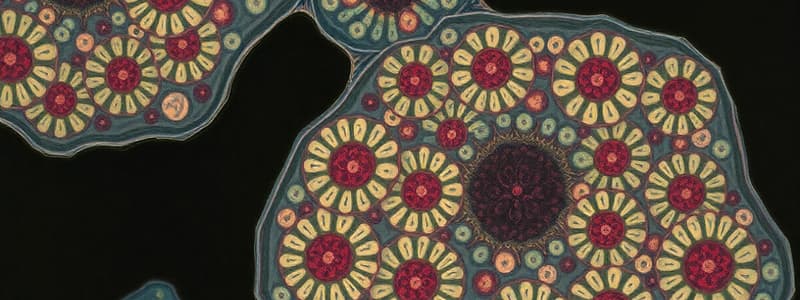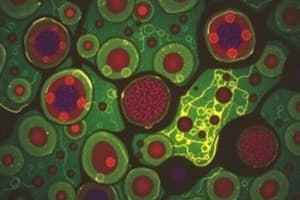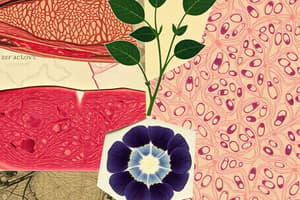Podcast
Questions and Answers
What is the primary process involved in the removal of cellular components during apoptosis?
What is the primary process involved in the removal of cellular components during apoptosis?
- Phagocytosis (correct)
- Endocytosis
- Exocytosis
- Diffusion
What is the primary difference between apoptosis and necrosis?
What is the primary difference between apoptosis and necrosis?
- Apoptosis is a programmed cell death, while necrosis is a result of injury.
- Apoptosis involves cell shrinkage, while necrosis involves cell swelling.
- Apoptosis does not trigger an inflammatory response, while necrosis does.
- All of the above. (correct)
What is the primary factor that regulates the frequency of cell division?
What is the primary factor that regulates the frequency of cell division?
- The type of cell. (correct)
- The availability of nutrients.
- The age of the organism.
- The size of the organism.
What is the consequence of fewer cells being replaced by apoptosis as we age?
What is the consequence of fewer cells being replaced by apoptosis as we age?
How does necrosis contribute to the process of tissue repair?
How does necrosis contribute to the process of tissue repair?
What is the main function of the plasma membrane?
What is the main function of the plasma membrane?
What is the main component of the plasma membrane?
What is the main component of the plasma membrane?
Which of the following is NOT a characteristic of prokaryotic cells?
Which of the following is NOT a characteristic of prokaryotic cells?
What is the function of the proteins located within the plasma membrane?
What is the function of the proteins located within the plasma membrane?
What is the smallest functional unit of the body?
What is the smallest functional unit of the body?
What is the role of carbohydrates attached to membrane proteins?
What is the role of carbohydrates attached to membrane proteins?
Which of the following organelles is present in eukaryotic cells but absent in prokaryotic cells?
Which of the following organelles is present in eukaryotic cells but absent in prokaryotic cells?
Which of the following is NOT a function of the plasma membrane?
Which of the following is NOT a function of the plasma membrane?
Which of the following best describes the relationship between cells, tissues, organs, and systems?
Which of the following best describes the relationship between cells, tissues, organs, and systems?
What is the main function of a system in the human body?
What is the main function of a system in the human body?
What is the term for the process by which cells are programmed to self-destruct?
What is the term for the process by which cells are programmed to self-destruct?
What is an example of a eukaryotic cell?
What is an example of a eukaryotic cell?
What is the function of phagocytosis in the context of cell death?
What is the function of phagocytosis in the context of cell death?
Which of the following is a characteristic of human cells?
Which of the following is a characteristic of human cells?
Why is it important that the plasma membrane remains intact?
Why is it important that the plasma membrane remains intact?
Why is the study of cellular biology important for understanding disease?
Why is the study of cellular biology important for understanding disease?
What is the primary function of lysosomes?
What is the primary function of lysosomes?
Which of the following structures is NOT part of the cytoskeleton?
Which of the following structures is NOT part of the cytoskeleton?
What is the primary role of microfilaments in the cell?
What is the primary role of microfilaments in the cell?
Which of the following is NOT a function of microtubules?
Which of the following is NOT a function of microtubules?
What is the main function of intermediate filaments?
What is the main function of intermediate filaments?
During which phase of the cell cycle does the cell's genetic material duplicate?
During which phase of the cell cycle does the cell's genetic material duplicate?
Why is cell division important for maintaining tissue integrity?
Why is cell division important for maintaining tissue integrity?
Which of the following is NOT a characteristic of the cell cycle?
Which of the following is NOT a characteristic of the cell cycle?
What is the primary function of RNA in protein synthesis?
What is the primary function of RNA in protein synthesis?
Which of the following is NOT a function of proteins in the body?
Which of the following is NOT a function of proteins in the body?
What is the role of cristae in mitochondria?
What is the role of cristae in mitochondria?
What is the main difference between the outer and inner membrane of mitochondria?
What is the main difference between the outer and inner membrane of mitochondria?
Which of the following statements accurately describes the relationship between DNA and proteins?
Which of the following statements accurately describes the relationship between DNA and proteins?
Why do cells with high energy requirements, like skeletal muscle cells, have more mitochondria?
Why do cells with high energy requirements, like skeletal muscle cells, have more mitochondria?
What is the significance of the statement that mitochondria are “sausage-shaped” and “central to aerobic respiration”?
What is the significance of the statement that mitochondria are “sausage-shaped” and “central to aerobic respiration”?
What is the role of functional proteins in the body?
What is the role of functional proteins in the body?
What is the primary function of the nucleus in a cell?
What is the primary function of the nucleus in a cell?
Which of the following is NOT a component of the cytosol?
Which of the following is NOT a component of the cytosol?
What happens to DNA in the nucleus when a cell prepares to divide?
What happens to DNA in the nucleus when a cell prepares to divide?
What is the role of ribosomes in the cell?
What is the role of ribosomes in the cell?
What is the function of the nuclear envelope?
What is the function of the nuclear envelope?
What is the difference between chromatin and chromosomes?
What is the difference between chromatin and chromosomes?
What is the significance of the fact that skeletal muscle cells have multiple nuclei?
What is the significance of the fact that skeletal muscle cells have multiple nuclei?
Why are mature red blood cells (erythrocytes) unique in that they lack a nucleus?
Why are mature red blood cells (erythrocytes) unique in that they lack a nucleus?
Flashcards
Cytoplasm
Cytoplasm
The gel-like substance between the nucleus and cell membrane, containing organelles.
Cytosol
Cytosol
The liquid component of cytoplasm where organelles float, made of a complex solution.
Apoptosis
Apoptosis
Programmed cell death where cells self-destruct when aged.
Functions of Cytoplasm
Functions of Cytoplasm
Signup and view all the flashcards
Plasma membrane
Plasma membrane
Signup and view all the flashcards
Nucleus
Nucleus
Signup and view all the flashcards
Nuclear envelope
Nuclear envelope
Signup and view all the flashcards
Bilateral layer
Bilateral layer
Signup and view all the flashcards
DNA
DNA
Signup and view all the flashcards
Membrane proteins
Membrane proteins
Signup and view all the flashcards
RNA
RNA
Signup and view all the flashcards
Hydrophobic vs Hydrophilic
Hydrophobic vs Hydrophilic
Signup and view all the flashcards
Nucleolus
Nucleolus
Signup and view all the flashcards
Transmembrane proteins
Transmembrane proteins
Signup and view all the flashcards
Receptors
Receptors
Signup and view all the flashcards
Sodium/Potassium pump
Sodium/Potassium pump
Signup and view all the flashcards
Basic Unit of Life
Basic Unit of Life
Signup and view all the flashcards
Hierarchy of Structure
Hierarchy of Structure
Signup and view all the flashcards
Prokaryotic Cells
Prokaryotic Cells
Signup and view all the flashcards
Eukaryotic Cells
Eukaryotic Cells
Signup and view all the flashcards
Types of Tissues
Types of Tissues
Signup and view all the flashcards
Homeostasis
Homeostasis
Signup and view all the flashcards
Cellular Biology
Cellular Biology
Signup and view all the flashcards
Multicellular Organization
Multicellular Organization
Signup and view all the flashcards
Cell Cycle
Cell Cycle
Signup and view all the flashcards
Phagocytosis
Phagocytosis
Signup and view all the flashcards
Necrosis
Necrosis
Signup and view all the flashcards
Inflammatory Response
Inflammatory Response
Signup and view all the flashcards
Protein synthesis
Protein synthesis
Signup and view all the flashcards
Functional proteins
Functional proteins
Signup and view all the flashcards
Haemoglobin
Haemoglobin
Signup and view all the flashcards
Mitochondria
Mitochondria
Signup and view all the flashcards
ATP
ATP
Signup and view all the flashcards
Cristae
Cristae
Signup and view all the flashcards
Lysosomes
Lysosomes
Signup and view all the flashcards
Intracellular digestion
Intracellular digestion
Signup and view all the flashcards
Cytoskeleton
Cytoskeleton
Signup and view all the flashcards
Microfilaments
Microfilaments
Signup and view all the flashcards
Microtubules
Microtubules
Signup and view all the flashcards
Intermediate filaments
Intermediate filaments
Signup and view all the flashcards
Study Notes
Introduction to Cells
- Cells are the fundamental building blocks of the body.
- Similar cells group together to form tissues.
- Tissues group together to form organs.
- Organs group together to form organ systems.
- Organ systems work together to maintain an organism.
Two Main Classes of Cells
- Prokaryotic cells: Do not have a nucleus, organelles not enclosed by membranes.
- Eukaryotic cells: Well-defined nucleus, many organelles enclosed by membranes.
The Animal Cell
- Cells are the smallest functional unit within the body.
- Cells have diverse shapes and sizes depending on their function.
- Cells, tissues, organs, and systems collectively maintain homeostasis.
- Cells reproduce, communicate, and have a lifespan.
Plasma Membrane
- Located on the outside of the cell; phospholipid bilayer with proteins and sugars.
- Regulates what enters and leaves the cell and how the cell responds to signals (e.g., hormones, neurotransmitters).
Cytoplasm
- Fills the space between the nucleus and the cell membrane.
- Cytoplasm consists of the cytosol, organelles and other components essential for cell function.
- Cytosol is the liquid found in the inside of cells.
Nucleus
- Largest organelle in the cell.
- Contains genetic material (DNA) and controls cell activities (metabolic activities).
- When a cell is not dividing, the genetic material is in threads called chromatin.
- When dividing, the genetic material forms chromosomes.
- Contains RNA which is important in protein synthesis.
Deoxyribonucleic Acid (DNA)
- DNA carries genetic information to determine characteristics and the formation of proteins.
- The proteins, formed according to the DNA information, determine structure and function within the cell and the whole body.
- DNA is within chromosomes.
Protein Synthesis
- Protein synthesis involves transcription and translation, ultimately creating proteins for diverse roles.
- A video resource is available for further information on protein synthesis.
Mitochondria
- Mitochondria are responsible for aerobic respiration, producing energy in the form of ATP.
- They have a double membrane, with the inner membrane folded into cristae to increase surface area.
- Cells with high energy requirements will have more mitochondria.
Other Cytoplasmic Organelles
- Includes the endoplasmic reticulum (rough and smooth), ribosomes.
- Endoplasmic reticulum is a network of channels for synthesizing and transporting proteins and other cell components.
- Ribosomes are protein synthesis sites.
Golgi Complex
- Modifies, packages, and transports proteins synthesized in the endoplasmic reticulum.
- Essential for secretion of substances outside the cell.
Lysosomes
- Sac-like structures containing enzymes to break down wastes inside the cell.
- Breakdown products are recycled, or removed.
Cytoskeleton
- A network of protein fibres that determines cell shape, supports the cell, and allows movement and intracellular transport.
- The cytoskeleton comprises microfilaments, microtubules, and intermediate filaments.
The Cell Cycle
- The cell cycle ensures that cells divide and reproduce in a controlled manner.
- This process is carefully regulated for effective tissue maintenance.
- The cycle consists of periods of growth, DNA replication, and division.
Apoptosis
- Apoptosis is a normal programmed cell death process that eliminates damaged or no longer needed cells.
- It is different to necrosis, which is cell death due to a lack of oxygen (hypoxia).
Apoptosis vs Necrosis
-
Necrosis involves leakage of cell components, and triggers inflammation.
-
There are differences between apoptosis and necrosis, one being inflammation response.
Further Reading
- Recommended textbook for further study, including details of cell-related concepts.
Studying That Suits You
Use AI to generate personalized quizzes and flashcards to suit your learning preferences.




